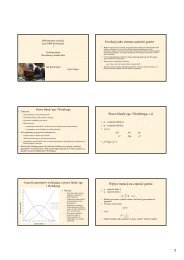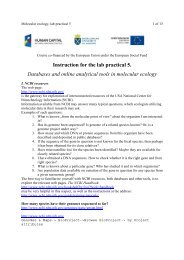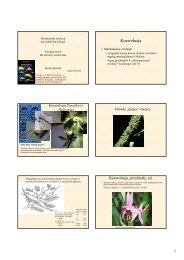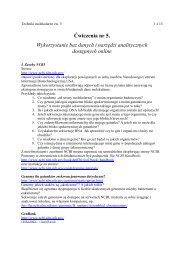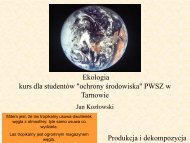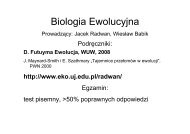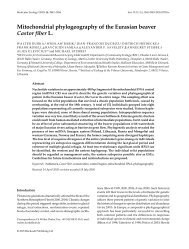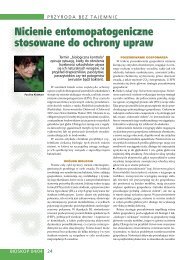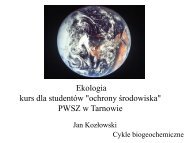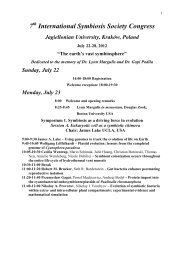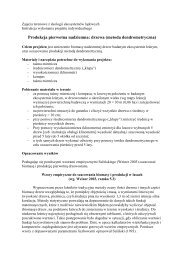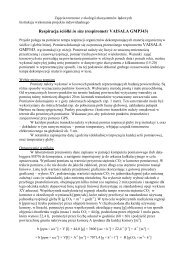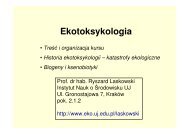Strong association between a single gene and fertilization efficiency ...
Strong association between a single gene and fertilization efficiency ...
Strong association between a single gene and fertilization efficiency ...
You also want an ePaper? Increase the reach of your titles
YUMPU automatically turns print PDFs into web optimized ePapers that Google loves.
310 M. Konior <strong>and</strong> others PGDH <strong>and</strong> sperm competition<br />
we tested whether the fecundity of females was influenced<br />
by the genotype of males. These experiments were<br />
prompted by previous studies indicating the presence of<br />
sexually antagonistic <strong>gene</strong>s having a positive effect on male<br />
reproductive success while decreasing the fitness of<br />
females mating with males harbouring such <strong>gene</strong>s (Rice<br />
1996; Friberg & Arnqvist, 2003).<br />
2. MATERIAL AND METHODS<br />
(a) PGDH allozymes<br />
The fast (F) <strong>and</strong> slow (S) phosphogluconate dehydrogenase<br />
(PGDH, EC 1.1.1.44) electromorphs were separated by<br />
cellulose acetate electrophoresis. Cellulose acetate plates<br />
(Malta Chemetron, Milano, Italy) were soaked for 20 min<br />
in 10% TME 7.4 (0.1 M Tris, 0.1 M maleic acid, 0.01 M<br />
diosodium EDTA, 0.01 M MgCl 2 $6H 2 O, adjusted to pH 7<br />
with KOH). Before samples were applied, the plates were<br />
gently dried on filter paper. Individual mites were homogenized<br />
in 3 ml of distilled water containing NADP<br />
(5 mg/100 ml) <strong>and</strong> immediately transferred onto the plate.<br />
The plate was loaded with seven samples, <strong>and</strong> the eighth lane<br />
contained a mixture of FF <strong>and</strong> SS homozygotes from preselected<br />
sub-populations (see below) <strong>and</strong> served as a<br />
reference. The plate was placed in a horizontal tank <strong>and</strong><br />
run in 10% TME 7.4 buffer at 170–250 V, ca 4 mA for<br />
20–30 min at room temperature. Plates were stained with<br />
5 ml 0.2 M Tris HCl pH 8.90, 0.1 ml MgCl 2 , 10 mg<br />
6-phosphogluconic acid, 0.1 ml NADP, 0.1 ml PMS <strong>and</strong><br />
0.1 ml MTT.<br />
(b) Re-analysis of previous data<br />
As a part of a survey of enzymatic polymorphism in the genus<br />
Rhizoglyphus. Kołodziejczyk et al. (2002) conducted a<br />
preliminary study to determine whether Pgdh could be used<br />
as a marker of paternity in R. robini (Kołodziejczyk et al.<br />
2002). In that study females from a population made<br />
homozygous for the S allele were mated with two males<br />
r<strong>and</strong>omly selected from a stock population. The males were<br />
then genotyped, <strong>and</strong> paternity was analysed for the doublematings<br />
that involved males homozygous for the two<br />
alternative alleles (i.e. five double-matings in which a female<br />
mated first with a SS male <strong>and</strong> 14 matings where the female<br />
mated first with a FF male, see Kołodziejczyk et al. 2002 for<br />
further details), but the test comparing P 2 (proportion of eggs<br />
fertilized by the second male) <strong>between</strong> these two mating<br />
orders was not reported. Here, we present a reanalysis of that<br />
data in which we compare <strong>fertilization</strong> success of males<br />
homozygous for alternative Pgdh alleles.<br />
(c) The mites<br />
The mites came from a founding population of about 100<br />
mites obtained from onions collected in 2001 near Krakówin<br />
Pol<strong>and</strong> <strong>and</strong>, after population expansion, maintained as a large<br />
stock culture (further referred to as 2001 stock culture)<br />
containing over 500 individuals. The mites were maintained<br />
in desiccators at room temperature <strong>and</strong> O90% relative<br />
humidity. Individuals were fed ad libitum with a 3 : 1 mixture<br />
of powdered yeast <strong>and</strong> wheat germ. Three weeks after the<br />
mites were brought to the laboratory, i.e. when the first labreared<br />
<strong>gene</strong>ration achieved maturity, a sample of 42 females<br />
was genotyped to determine whether the population was<br />
polymorphic at Pgdh (we used females because they are larger<br />
<strong>and</strong> easier to genotype). Another 40 females were genotyped<br />
in 2004 to determine whether the frequency of the two Pgdh<br />
alleles had changed after 3 years of laboratory rearing (i.e.<br />
after about 60 <strong>gene</strong>rations).<br />
(d) Homozygous sub-populations<br />
After two months of laboratory rearing we established two<br />
sub-populations homozygous for Pgdh (i.e. the SS <strong>and</strong> FF<br />
sub-populations). The SS sub-population was established<br />
by mixing the progeny of 20 pairs of parents homozygous<br />
for the S allele (4 offspring per pair). Both parents were<br />
genotyped after they produced progeny. Because the F<br />
allele is uncommon it was not possible to use the same<br />
procedure to establish an FF population in a <strong>single</strong><br />
<strong>gene</strong>ration. The FF sub-population was established over<br />
two <strong>gene</strong>rations. In the first <strong>gene</strong>ration, we mated females<br />
with one male <strong>and</strong> selected 4–8 offspring in families where<br />
each parent had at least one copy of the F allele (parents<br />
were genotyped after offspring were produced). In the next<br />
<strong>gene</strong>ration we coupled these families at r<strong>and</strong>om <strong>and</strong> for<br />
each couple we paired males from one family with females<br />
from another family <strong>and</strong> vice versa (i.e. 4–8 pairs per couple<br />
of families). Subsequent genotyping of these pairs revealed<br />
13 couples of families containing at least one pair of mates<br />
both homozygous for the F allele. These 13 pairs of<br />
individuals were unrelated within pairs <strong>and</strong> across pairs,<br />
<strong>and</strong> we used 4 offspring from each pair to establish the FF<br />
sub-population.<br />
The sub-populations were then allowed to exp<strong>and</strong> for<br />
about three months. During that time, each sub-population<br />
was maintained in a 2.5 cm diameter tube under identical<br />
regimes. All the experiments described below were completed<br />
within six months after the end of the expansion period.<br />
Before conducting the sperm competition <strong>and</strong> male harmfulness<br />
experiments we isolated larvae in 0.8 cm diameter glass<br />
tubes (2 cm high) with Plaster of Paris bases soaked with<br />
water. All these tubes were placed in the same desiccator<br />
throughout larval development (about 6 days). After adult<br />
males emerged, they remained in the same tubes <strong>and</strong> were<br />
supplied with a female from the stock population. They<br />
remained paired for 2 days before being used for experiments.<br />
This was done to mimic the natural situation of this colonial<br />
species where males have constant access to females.<br />
Additionally, this helped to st<strong>and</strong>ardize reserves of semen<br />
<strong>between</strong> males (Radwan 1997).<br />
(e) Sperm competition<br />
12 FF <strong>and</strong> 12 SS virgin females were sequentially presented<br />
with two males. Each male was paired for 2 h with the<br />
female. This time was sufficient for the majority of pairs to<br />
mate (in a similar setting, (Radwan et al. 2005) recorded<br />
about 90% pairs initiating copulation within 90 min,<br />
nZ60), but not long enough for repeated matings to<br />
occur. In half of the experiments the female was presented<br />
first with a FF male then with a SS male while in the other<br />
half male order was reversed. After mating the females were<br />
allowed to lay eggs for 5 days, after which both parents were<br />
genotyped to confirm that they were both homozygous for<br />
the F or S alleles. After progeny matured, 20 individuals<br />
were r<strong>and</strong>omly selected from each family to be genotyped<br />
at Pgdh.<br />
(f) Female genotype <strong>and</strong> fecundity<br />
To determine whether the <strong>gene</strong>tic correlation <strong>between</strong> sperm<br />
competitiveness <strong>and</strong> fecundity uncovered in previous studies<br />
Proc. R. Soc. B (2006)



